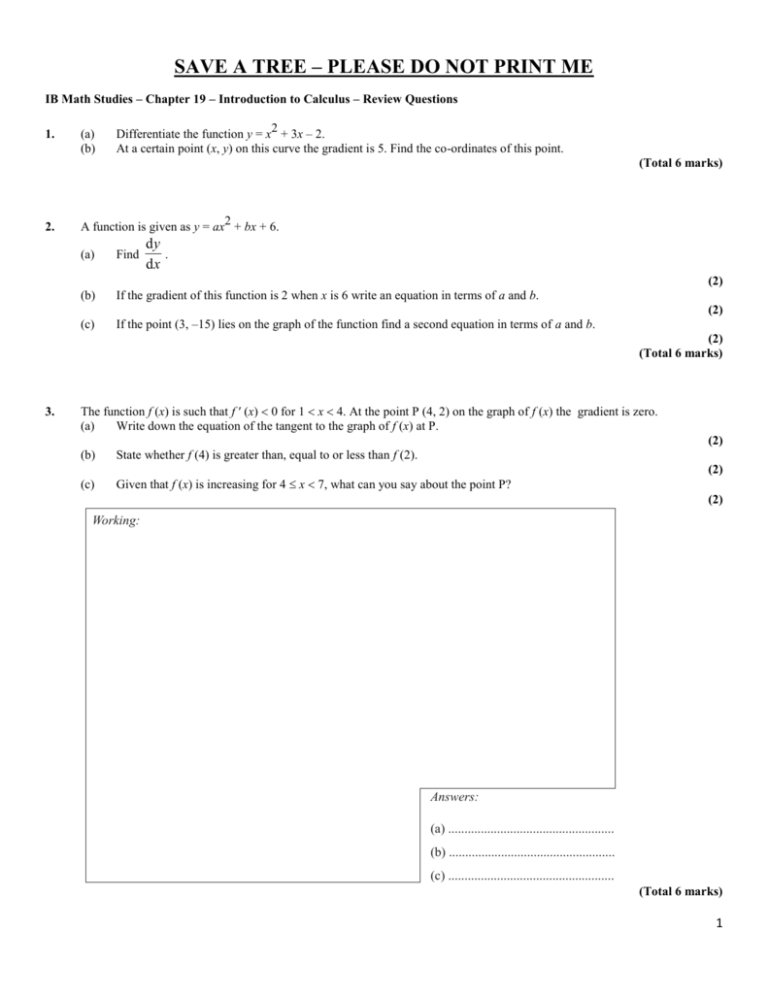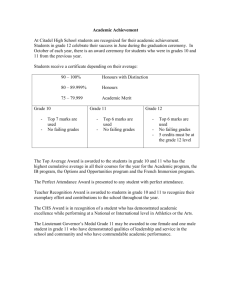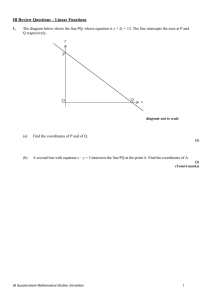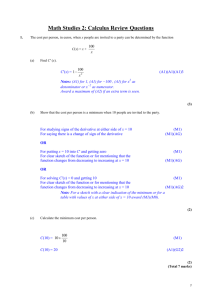Chpt 19 Review Questions
advertisement

SAVE A TREE – PLEASE DO NOT PRINT ME IB Math Studies – Chapter 19 – Introduction to Calculus – Review Questions 1. (a) (b) 2 Differentiate the function y = x + 3x – 2. At a certain point (x, y) on this curve the gradient is 5. Find the co-ordinates of this point. (Total 6 marks) 2. 2 A function is given as y = ax + bx + 6. dy . dx (a) Find (b) If the gradient of this function is 2 when x is 6 write an equation in terms of a and b. (c) If the point (3, –15) lies on the graph of the function find a second equation in terms of a and b. (2) (2) (2) (Total 6 marks) 3. The function f (x) is such that f ′ (x) 0 for 1 x 4. At the point P (4, 2) on the graph of f (x) the gradient is zero. (a) Write down the equation of the tangent to the graph of f (x) at P. (2) (b) State whether f (4) is greater than, equal to or less than f (2). (c) Given that f (x) is increasing for 4 x 7, what can you say about the point P? (2) (2) Working: Answers: (a) ................................................... (b) ................................................... (c) ................................................... (Total 6 marks) 1 4. 3 2 Consider the function f (x) = x + 7x – 5x + 4. (a) Differentiate f (x) with respect to x. (3) (b) Calculate f ′(x) when x = 1. (c) Calculate the values of x when f ′(x) = 0. (d) Calculate the coordinates of the local maximum and the local minimum points. (e) On graph paper, taking axes –6 x 3 and 0 y 80, draw the graph of f (x) indicating clearly the local maximum, local minimum and y-intercept. (2) (3) (2) (4) (Total 14 marks) 5. A farmer wishes to enclose a rectangular field using an existing fence for one of the four sides. Existing fence x (a) y Write an expression in terms of x and y that shows the total length of the new fence. (1) (b) The farmer has enough materials for 2500 metres of new fence. Show that y = 2500 – 2x (1) (c) A(x) represents the area of the field in terms of x. (i) Show that 2 A(x) = 2500x – 2x (2) (ii) Find A'(x). (iii) Hence or otherwise find the value of x that produces the maximum area of the field. (iv) Find the maximum area of the field. (1) (3) (3) (Total 11 marks) 6. 3 2 The function f (x) is given by f (x) = x – 3x + 3x, for –1 ≤ x ≤ 3. (a) Differentiate f (x) with respect to x. (2) (b) Complete the table below. x –1 0 1 f (x) 0 1 f '(x) 12 0 2 2 3 9 12 (3) (c) Use the information in your table to sketch the graph of f (x). (2) (d) Write down the gradient of the tangent to the curve at the point (3, 9). (1) (Total 8 marks) 2 7. 3 2 A function g (x) = x + 6x + 12x + 18 (a) Find g(x). (3) (b) Solve g(x) = 0. (2) (c) (i) Calculate the values of g(x) when (a) x = –3; (b) x = 0. (ii) Hence state whether the function is increasing or decreasing at (a) x = –3; (b) x = 0. (4) (Total 9 marks) 8. A closed box has a square base of side x and height h. (a) Write down an expression for the volume, V, of the box. (1) (b) Write down an expression for the total surface area, A, of the box. (1) The volume of the box is 1000 cm (c) Express h in terms of x. 3 (2) (d) Hence show that A = 4000x –l 2 + 2x . (2) (e) Find dA . dx (2) (f) Calculate the value of x that gives a minimum surface area. (4) (g) Find the surface area for this value of x. (3) (Total 15 marks) 3 9. 2 A farmer has a rectangular enclosure with a straight hedge running down one side. The area of the enclosure is 162 m . He encloses this area using x metres of the hedge on one side as shown on the diagram below. diagram not to scale x (a) If he uses y metres of fencing to complete the enclosure, show that y = x + 324 . x (3) The farmer wishes to use the least amount of fencing. dy . dx (b) Find (c) Find the value of x which makes y a minimum. (d) Calculate this minimum value of y. (3) (3) (2) (e) Using y = x + x y 324 find the values of a and b in the following table. x 6 60 9 45 12 39 18 a 24 37.5 27 b 36 45 (2) (f) Draw an accurate graph of this function using a horizontal scale starting at 0 and taking 2 cm to represent 10 metres, and a vertical scale starting at 30 with 4 cm to represent 10 metres. (g) Write down the values of x for which y increases. (5) (2) (Total 20 marks) 4 10. A cylinder is cut from a solid wooden sphere of radius 8 cm as shown in the diagram. The height of the cylinder is 2h cm. C h D h m 8c 8c m O E A B (a) Find AE (the radius of the cylinder), in terms of h. (b) Show that the volume (V) of the cylinder may be written as 2 3 V= 2h (64 – h ) cm . (c) (i) (2) (2) Determine, correct to three significant figures, the height of the cylinder with the greatest volume that can be produced in this way. (5) (ii) 3 Calculate this greatest volume, giving your answer correct to the nearest cm . (3) (Total 12 marks) 11. –1 The velocity, vms , of a kite, after t seconds, is given by 3 2 v = t – 4t + 4t, (a) What is the velocity of the kite after (i) one second? (ii) half a second? 0 t 4. (2) (b) Calculate the values of a and b in the table below. t 0 0.5 1 1.5 2 v 0 a 0 2.5 0.625 3 b 3.5 7.88 4 16 (2) (c) dv in terms of t. Find the value of t at the local maximum and minimum values of the function. dt (i) Find (ii) Explain what is happening to the function at its local maximum point. Write down the gradient of the tangent to its curve at this point. (8) (d) 3 2 On graph paper, draw the graph of the function v = t – 4t + 4t, 0 t 4. Use a scale of 2 cm to represent 1 second on the horizontal axis and 2 cm to represent 2 ms axis. –1 on the vertical (5) (e) Describe the motion of the kite at different times during the first 4 seconds. Write down the intervals corresponding to changes in motion. (3) (Total 20 marks) 5 12. A, B, C, D and E are points on the curve y = f(x) shown in the diagram below. E y y = f(x) D B A C x (a) Describe the gradient of the curve in passing from the point B, through point C to point D. (3) (b) D has coordinates (a, f(a)), and the x-coordinate at E is a + 4. Write an expression for the gradient of the line segment [DE]. (3) (Total 6 marks) 13. A closed box has a square base of side x and height h. (a) Write down an expression for the volume, V, of the box. (1) (b) Write down an expression for the total surface area, A, of the box. (1) The volume of the box is 1000 cm (c) Express h in terms of x. 3 (2) (d) Hence show that A = 4000x –l 2 + 2x . (2) (e) Find dA . dx (2) (f) Calculate the value of x that gives a minimum surface area. (4) (g) Find the surface area for this value of x. (3) (Total 15 marks) 6 IB Math Studies – Chapter 19 – Introduction to Calculus – Mark Scheme 1. (a) (b) 2x + 3 (–1 for each extra term) (A2) (C2) Note: If correct and an extra term included, award (A1) only. Equating the gradient to 5 (2x + 3 = 5) For solving attempt For x = l Co-ordinates (1, 2) (M1) (M1) (A1) (A1) (C4) [6] 2. (a) 2 y = ax + bx + 6 (A1)(A1) 2 dy = 2ax + b dx (b) (c) 3. (a) Gradient = 2 when x = 6. Therefore, 2 = 2a × 6 + b 2 = 12a + b y = –15 when x = 3. Therefore, –15 = 9a + 3b + 6 or –21 = 9a + 3b or –7 = 3a + b y = 2. Award (A1) for y =…, (A1) for 2. Accept f (x) =2 and y = 0x + 2 (b) Less (than). (c) Local minimum (accept minimum, smallest or equivalent) Award (A1) for stationary or turning point mentioned. Note: No mark is awarded for gradient = 0 as this is given in the question. (M1) (A1) 2 (M1)(A1) 2 [6] (A1)(A1) (C2) (A2) (C2) (A2) (C2) [6] 4. (a) 2 f(x) = 3x + 14x – 5 A1) (A1)(A1)( 3 (b) f(1) = 3 + 14 – 5 =12 (M1)(A1) (c) 2 3x + 14x – 5 = 0 (3x – 1)(x + 5) = 0 (M1) 1 x or 5 3 (A1)(A1) (or (G3)) (d) 2 3 1 , 3.15 (5, 79) 3 (A1)(A1) (or (G2)) 2 7 (e) (A4) 4 Note: Award (A1) for axes labelled, (A1) for maximum, (A1) for minimum, (A1) for y-intercept. [14] 5. (a) 2x + y (A1) 1 (b) 2500 = 2x + y 2500 – 2x = y (M1) (AG) 1 (i) Area A(x) = xy = x(2500 – 2x) 2 = 2500x – 2x (M1) (M1) (AG) 2 A(x) = 2500 – 4x A(x) = 0 0 = 2500 – 4x 4x = 2500 x = 625 (A1) 1 (M1) (M1) (A1) 3 (c) (ii) (iii) (iv) 2 A(x) = 2500x – 2x 2 A(625) = 2500 × 625 – 2(625) = 781250 2 = 781000 m (M2) (A1) 3 [11] 6. (a) 2 f (x) = 3x – 6x + 3 (A2) 2 (b) x f(x) f (x) –1 –7 12 0 0 3 1 1 0 2 2 3 3 9 12 (A3) 3 8 (c) y 10 8 6 4 2 0 –1 F x 1 2 3 4 –2 –4 –6 –8 –10 Note: The graph does not have to be on graph paper as long as it is reasonable. (d) 12 (A2) 2 (A1) 1 [8] 7. (a) (b) (c) 2 g(x) = 3x + 12x + 12 (A3) 2 3x + 12x + 12 = 0 2 x + 4x + 4 = 0 2 (x + 2) = 0 x = –2 (M1) (i) (ii) (iii) dy =3 dx dy x=0 = 12 dx x = –3 (a) (b) Increasing Increasing 3 (A1) or (G2) 2 (A1) (A1) (A1) (A1) 4 [9] 9 8. (a) 2 V=x h (A1) 1 (b) 2 A = 2x + 4xh (A1) 1 (c) 2 1000 = x h (M1) 1000 h= x2 (A1) (d) (e) (f) (g) 1000 2 A = 2x + 4x 2 x 2 4000 A = 2x + x 2 (M1) (A1) 2 –1 = 2x + 4000x (AG) 2 dA –2 = 4x – 4000x dx (A2) 2 –2 4x – 4000x = 0 3 4x – 4000 = 0 3 4x = 4000 3 x = 1000 x = 10 OR x = 10 h= (M1) (M1) (A1) (A1) (G4) 1000 = 10 100 4 (A1) A = 2(100) + 4(10)(10) = 200 + 400 = 600 OR A = 600 (M1) (A1) (G3) 3 [15] 9. (a) y=x+z+z (M1) Note: Award (M1) for writing a sensible equation. xz = 162 z 162 x (M1) 2162 x 324 yx x yx (b) (M1) (AG) dy 324 1 2 dx x 3 (A1)(A1)(A1) Note: Award (A1) for 1 and no other constant present, (A1) for –324, (A1) for or x –2 3 1 x2 . 10 (c) dy 0 dx 324 1 2 0 x (M1) Note: Award (M1) for putting candidate’s derivative equal to zero. 2 x = 324 x = 18 (d) (A1)(ft) (A1)(ft)(G3) y = 18 + 9 + 9 3 (M1) Note: Award (M1) for adding three sides of rectangle. = 36 OR 18 (e) (A1)(ft)(G2) 324 18 (M1) = 36 (A1)(ft) 2 a = 36 b = 39 (A1) (A1) 2 (f) (A5)(ft) 5 Notes: Award (A1) for correct scales and labels, (A3) for correct points plotted, (A1) for smooth curve with (18, 36) as the minimum value. Award (A2) for 5 or 6 points correctly plotted, (A1) for 3 or 4 points correctly plotted. (g) x 18 Notes: Award (A1) for x , (A1) for 18. Accept x > 18 (A1)(A1)(ft) 2 [20] 11 10. (a) (b) 2 2 2 AE + OE = OA ................................. (3) 2 2 2 AE + k = 8 Note: Award (M1) for using and substituting correctly in equation (3). 2 2 AE = 64 h (M1) 2 Volume (V) = 2hr (M1) (A1) 2 (c) (i) = 2h(AE ) (M1) 2 3 = 2h(64 – h ) cm ........................... (4) (AG) 3 From (b) V = 128h – 2h Note: Award (M1) for using equation (4) or any other correct approach. (M1) dV 2 = 128 – 6h = 0 at maximum/minimum points dh (M2) 2 2 Note: Award (M2) for correctly differentiating V w.r.t. x. h= 64 = ±4.62 cm (3 s.f.) 3 (A1) Test to show that V is maximum when h = 4.62 Note: Award (R1) for testing to confirm V is indeed maximum. (ii) (R1) 5 2 2 AE = 64 – h = 64 – 64 128 3 3 (M1) Notes: Follow through with candidate’s AE from part (a) (M1) is for correctly 2 obtaining candidate’s AE . 128 64 2 Therefore maximum volume = r (2h) = 2 3 (M1) 3 2 Note: Follow through with candidate’s AE 3 3 = 1238.7187...= 1239 cm (nearest cm ) Notes: Correct answer only. 3 Accept 1238 cm if and only if candidate uses = 3.14 (A1) 3 [12] 11. (a) (i) (ii) (b) 3 2 v(1) = 1 – 4(1) + 4(1) –1 = 1 ms (A1) 3 2 v(0.5) = (0.5) – 4(0.5) + 4(0.5) –1 = 1.125 ms accept 1.13 (3 s.f.) 3 a = v(1.5) = 1.5 – 4(1.5) + 4(1.5) = 0.375 3 2 b = v(3) = 3 – 4(3 ) + 4(3) =3 Table (not required) t 0 0.5 1 1.5 v 0 1.125 1 0.375 (A1) 2 (A1) 2 (A1) 2 0 2.5 0.625 3 3 3.5 7.875 4 16 12 (c) dv 2 = 3t – 8t + 4 dt (A1) 2 3t – 8t + 4 = 0 (3t – 2)(t – 2) = 0 (M1) (M1) (i) t= (ii) 2 ,t=2 3 (A1)(A1) The function is changing from acceleration to deceleration or velocity changes from increasing to decreasing or kite is stationary or velocity is zero Note: Award (R1) for acceleration, (R1) for deceleration. Gradient = 0 (R1)(R1) (A1) 8 (A5) 5 (d) v (m/sec) 16 14 12 10 8 6 4 2 1 2 3 4 5 t sec Note: Award (A1) for axes correctly labelled, (A1) if scales correct, (A1) for correct general shape of curve, (A1) for each turning point in approximately the correct place. (e) time t t=0 0<t< t= 2 3 2 3 motion stopped accelerating (increasing in velocity) (A1) stopped accelerating 2 <t<2 3 decelerating (decreasing in velocity) (A1) t=2 2<t4 stopped decelerating accelerating Note: Stops may be left out (A1) 3 [20] 13 12. (a) (b) At B, the gradient is zero. From B to C, the gradient is negative. At C, the gradient is zero. From C to D, the gradient is positive. At D, the gradient is zero. Note: Award [½ mark] for each correct statement and round up. Gradient = = (A3) 3 y 2 y1 x 2 x1 f (a 4) f (a) (a 4) (a) (M2) Note: Award (M1) for f(a + 4) = f (a 4) f (a) 4 (A1) 3 [6] 13. (a) 2 V=x h (A1) 1 (b) 2 A = 2x + 4xh (A1) 1 (c) 2 1000 = x h (M1) h= (d) (e) (f) (g) 1000 x2 (A1) 1000 2 A = 2x + 4x 2 x 4000 2 A = 2x + x 2 (M1) (A1) 2 –1 = 2x + 4000x (AG) 2 dA –2 = 4x – 4000x dx (A2) 2 –2 4x – 4000x = 0 3 4x – 4000 = 0 3 4x = 4000 3 x = 1000 x = 10 OR x = 10 h= 1000 = 10 100 A = 2(100) + 4(10)(10) = 200 + 400 = 600 OR A = 600 (M1) (M1) (A1) (A1) (G4) 4 (A1) (M1) (A1) (G3) 3 [15] 14





